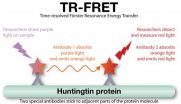(Press-News.org) HEIDELBERG, 17 September 2012 – A natural product secreted by a soil bacterium shows promise as a new drug to treat tuberculosis report scientists in a new study published in EMBO Molecular Medicine. A team of scientists working in Switzerland has shown how pyridomycin, a natural antibiotic produced by the bacterium Dactylosporangium fulvum, works. This promising drug candidate is active against many of the drug-resistant types of the tuberculosis bacterium that no longer respond to treatment with the front-line drug isoniazid.
"Nature and evolution have equipped some bacteria with potent defense mechanisms to protect them against other bugs that share their habitat. Screening natural products generated by these organisms is therefore a powerful way to find possible new drugs to fight infectious diseases," said Stewart Cole, lead author of the study, EMBO Member and a professor at the École Polytechnique Fédérale de Lausanne (EPFL), Switzerland. "Using this approach we have shown that nature's antibiotic pyridomycin is a very selective killer of Mycobacterium tuberculosis, the bacterium responsible for tuberculosis in humans. It is also active against mycobacteria that have developed resistance to front-line drug treatments such as isoniazid."
Tuberculosis causes up to two million deaths annually. There is a significant need for new drugs since the effectiveness of current antibiotics is compromised by the increasing prevalence of drug-resistant tuberculosis. The most effective drugs used to treat tuberculosis, for example isoniazid and rifampicin, are often no longer effective.
The researchers identified a protein, the enzyme NADH-dependent enoyl(acyl carrier protein) reductase or InhA, which is the principal target for the antibiotic. "By selecting and isolating M. tuberculosis mutants resistant to pyridomycin and sequencing their genome we have found that a single gene named inhA is responsible for resistance to this natural product," added Cole.
The gene inhA is needed to produce the InhA protein, which is already known as a target for tuberculosis drug isoniazid. It turns out that pyridomycin can bind to the same pocket on the InhA enzyme as isoniazid but at a different site and in a way that involves a different sequence of molecular events. It is these differences that give pyridomycin the ability to overcome drug-resistant strains of mycobacteria.
The scientists showed that in live bacteria treatment with pyridomycin leads to the depletion of mycolic acids, fatty acids that are an essential component of the bacterial cell wall.
"Our finding that pyridomycin kills Mycobacterium tuberculosis by inhibiting InhA, even in clinically isolated bacteria that are resistant to the drug isoniazid, provides a great opportunity to develop pyridomycin or a related agent for the treatment of drug-resistant tuberculosis," remarked Cole.
### Towards a new tuberculosis drug: Pyridomycin – Nature's isoniazid
Ruben C Hartkoorn, Claudia Sala, João Neres, Florence Pojer, Sophie J. Magnet, Raju Mukherjee, Swapna Uplekar, Stefanie Boy-Röttger, Karl-Heinz Altmann, Stewart T. Cole
Read more about Dr. Cole's research:
http://actu.epfl.ch/news/old-news-is-good-news-for-tb-drug-discovery/
Further information on EMBO Molecular Medicine is available at www.embomolmed.org
Media Contacts
Barry Whyte
Head | Public Relations and Communications
Yvonne Kaul
Communications Offer
Tel: +49 6221 8891 108/111
communications@embo.org
About EMBO
EMBO stands for excellence in the life sciences. The organization enables the best science by supporting talented researchers, stimulating scientific exchange and advancing policies for a world-class European research environment.
EMBO is an organization of 1500 leading life scientist members that fosters new generations of researchers to produce world-class scientific results. EMBO helps young scientists to advance their research, promote their international reputations and ensure their mobility. Courses, workshops, conferences and scientific journals disseminate the latest research and offer training in cutting-edge techniques to maintain high standards of excellence in research practice. EMBO helps to shape science and research policy by seeking input and feedback from our community and by following closely the trends in science in Europe.
For more information: www.embo.org
Scientists reveal how natural antibiotic kills tuberculosis bacterium
2012-09-17
ELSE PRESS RELEASES FROM THIS DATE:
Improved positioning indoors
2012-09-17
The NAVVIS positioning system is primarily based on visual information. The TUM researchers had to develop a special location recognition system for this project. They started by taking photos of a building, simultaneously mapping prominent features like stairs and signs. A smartphone app then lets users view the map images to find their current location. All they have to do is take a photo of their surroundings. The program then compares the photo with the images stored in its database and works out the user's exact position (down to the nearest meter) and the direction ...
Noteworthy studies at the ESMO 2012 Congress
2012-09-17
Lugano, Switzerland, 14 September 2012 -- Ahead of the top 48 abstracts (LBA and PR suffix) that will be released during the ESMO 2012 Congress, over 1,600 abstracts will be published online on Monday, 17 September 2012 at 9:00 (CEST) to anticipate the flavor of an ESMO Congress that once again "will be presenting emerging strategies set to combat cancer, signposting future directions in patient treatment and care, boldly addressing the many new challenges that lie ahead." (Josep Tabernero, ESMO 2012 Scientific Chair)
http://www.esmo.org/events/vienna-2012-congress/program.html
--> ...
New 'ATM' takes old phones and gives back green
2012-09-17
When new cell phones or tablets enter the marketplace, yesterday's hot technology can quickly become obsolete - for some consumers. For others, the device still has value as an affordable alternative, or even as spare parts.
With support from the National Science Foundation (NSF), ecoATM of San Diego, Calif., has developed a unique, automated system that lets consumers trade in those devices for reimbursement or recycling.
Using sophisticated artificial intelligence (AI) developed through two NSF Small Business Innovation Research (SBIR) grants, ecoATM kiosks can ...
Toxic protein build-up in blood shines light on fatal brain disease
2012-09-17
A new light-based technique for measuring levels of the toxic protein that causes Huntington's disease (HD) has been used to demonstrate that the protein builds up gradually in blood cells. Published today (17th) in the Journal of Clinical Investigation, the findings shed light on how the protein causes damage in the brain, and could be useful for monitoring the progression of HD, or testing new drugs aimed at suppressing production of the harmful protein.
HD is a fatal, incurable, genetic neurological disease that usually develops in adulthood and causes abnormal involuntary ...
Results from study of Mead Johnson's Enfamil® Human Milk Fortifier Acidified Liquid published in Pediatrics
2012-09-17
[GLENVIEW, Ill., Sept. 17, 2012] – Mead Johnson Nutrition (NYSE: MJN) announced today results of a new study published in Pediatrics that shows Enfamil Human Milk Fortifier Acidified Liquid supports significantly higher growth in premature infants than powdered fortifiers and is well-tolerated. Enfamil Human Milk Fortifier Acidified Liquid is the first and only ultra-concentrated liquid human milk fortifier marketed in the United States that meets safety guidelines from the Academy of Nutrition and Dietetics (AND) and Centers for Disease Control and Prevention (CDC), as ...
Sorghum eyed as a southern bioenergy crop
2012-09-17
Sweet sorghum is primarily grown in the United States as a source of sugar for syrup and molasses. But the sturdy grass has other attributes that could make it uniquely suited to production as a bioenergy crop, U.S. Department of Agriculture (USDA) studies suggest.
Sorghum is an ideal candidate because of its drought tolerance, adaptability to diverse growing conditions, low nitrogen fertilizer requirements, and high biomass (plant material) content, according to molecular biologist Scott Sattler and collaborator Jeff Pedersen with USDA's Agricultural Research Service ...
Effectiveness and impact of climate change mitigation measures unclear
2012-09-17
Uncertainties relating to the assessment of effectiveness of emission reduction measures are considerable. In order to manage these, there is an evident need to develop uniform assessment methods for ensuring that the assumed emission reductions are also achieved in practice.
Significant mitigation of climate change is widely supported globally. Achieving the mitigation targets will require considerable reductions in global greenhouse gas emissions in the coming years. However, widely differing views, particularly of the large economies such as the EU, the United States, ...
Food industry's high-quality co-streams used effectively as raw material for new products
2012-09-17
Co-streams from the food industry are excellent sources of proteins and healthy oils for use in foods and cosmetics. However, at the moment these side streams are mainly used as fish and animal feed, for energy, or end up as waste.
Coordinated by VTT, the APROPOS (Added value from high protein and high oil containing industrial co-streams) project seeks to enrich several co-stream components at once from food quality co-streams of rapeseed/canola/mustard and fish. In particular, this project aims to promote the competitiveness of the SME sector and developing regional ...
VTT and GE Healthcare developing novel biomarkers to predict Alzheimer's disease
2012-09-17
Alzheimer's disease (AD) is a growing challenge to the health care systems and economies of developed countries with millions of patients suffering from this disease and increasing numbers of new cases diagnosed annually with the increasing ageing of populations.
Early detection of prodromal AD is vital both for assessing the efficacy of potential AD therapeutic agents as well as new disease modifying therapies are most likely to be effective when initiated during the early stages of disease. The elucidation of early metabolic pathways associated with progression to Alzheimer's ...
Your body doesn't lie: People ignore political ads of candidates they oppose
2012-09-17
COLUMBUS, Ohio - A recent study examined people's bodily responses while watching presidential campaign ads - and discovered another way that people avoid political information that challenges their beliefs.
In the last days of the 2008 campaign, researchers had people watch a variety of actual ads for Republican presidential candidate John McCain and his Democratic rival Barack Obama while the viewers' heart rates, skin conductance and activation of facial muscles were monitored.
The results showed that partisan participants reacted strongly to ads featuring their ...



